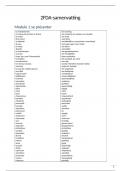Class notes
Applied Cog. Psychology (part 1)
- Course
- Institution
- Book
Part 2 of PSY3009F: "This course builds on the theoretical foundations taught in the Psy2014S course at UCT, and illustrates their real life applications in areas such as the criminal justice system, AI, real life decision making, sport, and education. It also helps one build and expand on the rese...
[Show more]









